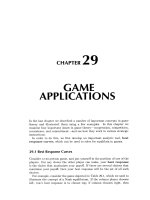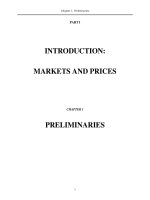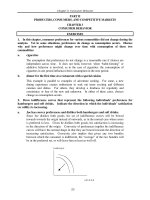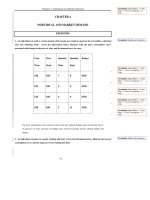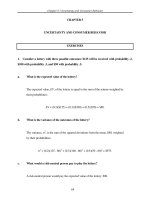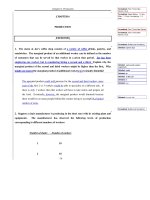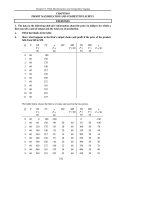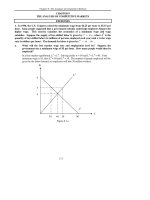Tài liệu Bài tập về Kinh tế vĩ mô bằng tiếng Anh - Chương 11 pdf
Bạn đang xem bản rút gọn của tài liệu. Xem và tải ngay bản đầy đủ của tài liệu tại đây (203.97 KB, 44 trang )
Chapter 11: Pricing with Market Power
160
CHAPTER 11
PRICING WITH MARKET POWER
EXERCISES
1. Price discrimination requires the ability to sort customers and the ability to prevent
arbitrage. Explain how the following can function as price discrimination schemes and
discuss both sorting and arbitrage:
a. Requiring airline travelers to spend at least one Saturday night away from home to
qualify for a low fare.
The requirement of staying over Saturday night separates business travelers, who
prefer to return for the weekend, from tourists, who travel on the weekend.
Arbitrage is not possible when the ticket specifies the name of the traveler.
b. Insisting on delivering cement to buyers and basing prices on buyers’ locations.
By basing prices on the buyer’s location, customers are sorted by geography.
Prices may then include transportation charges. These costs vary from customer to
customer. The customer pays for these transportation charges whether delivery is
received at the buyer’s location or at the cement plant. Since cement is heavy and
bulky, transportation charges may be large. This pricing strategy leads to “based-
point-price systems,” where all cement producers use the same base point and
calculate transportation charges from this base point. Individual customers are
then quoted the same price. For example, in FTC v. Cement Institute, 333 U.S.
683 [1948], the Court found that sealed bids by eleven companies for a 6,000-barrel
government order in 1936 all quoted $3.286854 per barrel.
Chapter 11: Pricing with Market Power
161
c. Selling food processors along with coupons that can be sent to the manufacturer to
obtain a $10 rebate.
Rebate coupons with food processors separate consumers into two groups: (1)
customers who are less price sensitive, i.e., those who have a lower elasticity of
demand and do not request the rebate; and (2) customers who are more price
sensitive, i.e., those who have a higher demand elasticity and do request the rebate.
The latter group could buy the food processors, send in the rebate coupons, and
resell the processors at a price just below the retail price without the rebate. To
prevent this type of arbitrage, sellers could limit the number of rebates per
household.
d. Offering temporary price cuts on bathroom tissue.
A temporary price cut on bathroom tissue is a form of intertemporal price
discrimination. During the price cut, price-sensitive consumers buy greater
quantities of tissue than they would otherwise. Non-price-sensitive consumers buy
the same amount of tissue that they would buy without the price cut. Arbitrage is
possible, but the profits on reselling bathroom tissue probably cannot compensate
for the cost of storage, transportation, and resale.
e. Charging high-income patients more than low-income patients for plastic surgery.
The plastic surgeon might not be able to separate high-income patients from low-
income patients, but he or she can guess. One strategy is to quote a high price
initially, observe the patient’s reaction, and then negotiate the final price. Many
medical insurance policies do not cover elective plastic surgery. Since plastic
surgery cannot be transferred from low-income patients to high-income patients,
arbitrage does not present a problem.
Chapter 11: Pricing with Market Power
162
2. If the demand for drive-in movies is more elastic for couples than for single individuals, it
will be optimal for theaters to charge one admission fee for the driver of the car and an extra
fee for passengers. True or False? Explain.
True. Approach this question as a two-part tariff problem where the entry fee is a
charge for the car plus the driver and the usage fee is a charge for each additional
passenger other than the driver. Assume that the marginal cost of showing the
movie is zero, i.e., all costs are fixed and do not vary with the number of cars. The
theater should set its entry fee to capture the consumer surplus of the driver, a single
viewer, and should charge a positive price for each passenger.
3. In Example 11.1, we saw how producers of processed foods and related consumer
goods use coupons as a means of price discrimination. Although coupons are widely used
in the United States, that is not the case in other countries. In Germany, coupons are
illegal.
a. Does prohibiting the use of coupons in Germany make German consumers better off
or worse off?
In general, we cannot tell whether consumers will be better off or worse off.
Total consumer surplus can increase or decrease with price discrimination,
depending on the number of different prices charged and the distribution of
consumer demand. Note, for example, that the use of coupons can increase the
market size and therefore increase the total surplus of the market. Depending on
the relative demand curves of the consumer groups and the producer’s marginal
cost curve, the increase in total surplus can be big enough to increase both
producer surplus and consumer surplus. Consider the simple example depicted
in Figure 11.3.a.
Chapter 11: Pricing with Market Power
AR
1
MR
1
AR
2
P
1
P
2
MR
2
Price
Quantity
Figure 11.3.a
In this case there are two consumer groups with two different demand curves.
Assuming marginal cost is zero, without price discrimination, consumer group 2
is left out of the market and thus has no consumer surplus. With price
discrimination, consumer 2 is included in the market and collects some consumer
surplus. At the same time, consumer 1 pays the same price under discrimination
in this example, and therefore enjoys the same consumer surplus. The use of
coupons (price discrimination) thus increases total consumer surplus in this
example. Furthermore, although the net change in consumer surplus is
ambiguous in general, there is a transfer of consumer surplus from price-
insensitive to price-sensitive consumers. Thus, price-sensitive consumers will
benefit from coupons, even though on net consumers as a whole can be worse off.
b. Does prohibiting the use of coupons make German producers better off or worse
off?
163
Chapter 11: Pricing with Market Power
Prohibiting the use of coupons will make the German producers worse off, or at
least not better off. If firms can successfully price discriminate (i.e. they can
prevent resale, there are barriers to entry, etc.), price discrimination can never
make a firm worse off.
4. Suppose that BMW can produce any quantity of cars at a constant marginal cost equal to
$20,000 and a fixed cost of $10 billion. You are asked to advise the CEO as to what prices
and quantities BMW should set for sales in Europe and in the U.S. The demand for BMWs
in each market is given by:
Q
E
= 4,000,000 - 100 P
E
and Q
U
= 1,000,000 - 20P
U
where the subscript E denotes Europe and the subscript U denotes the United States.
Assume that BMW can restrict U.S. sales to authorized BMW dealers only.
a. What quantity of BMWs should the firm sell in each market, and what will the price
be in each market? What will the total profit be?
With separate markets, BMW chooses the appropriate levels of Q
E
and Q
U
to
maximize profits, where profits are:
π
= TR−TC= Q
E
P
E
+Q
U
P
U
()− Q
E
+Q
U
(
)20,000+10,000,000,000
{
}
.
Solve for P
E
and P
U
using the demand equations, and substitute the expressions into
the profit equation:
π
= Q
E
40, 000 −
Q
E
100
⎛
⎝
⎞
⎠
+ Q
U
50, 000 −
Q
U
20
⎛
⎝
⎞
⎠
− Q
E
+ Q
U
()
20, 000 + 10,000,000,000
{}
.
164
Chapter 11: Pricing with Market Power
Differentiating and setting each derivative to zero to determine the profit-
maximizing quantities:
∂π
∂
Q
E
= 40,000 −
Q
E
50
− 20, 000 = 0, or Q
E
= 1,000 ,000 cars
and
∂π
∂
Q
U
= 50, 000 −
Q
U
10
− 20, 000 = 0, or Q
U
= 300, 000 cars.
Substituting Q
E
and Q
U
into their respective demand equations, we may determine
the price of cars in each market:
1,000,000 = 4,000,000 - 100P
E
, or P
E
= $30,000 and
300,000 = 1,000,000 - 20P
U
, or P
U
= $35,000.
Substituting the values for Q
E
, Q
U
, P
E
, and P
U
into the profit equation, we have
π = {(1,000,000)($30,000) + (300,000)($35,000)} - {(1,300,000)(20,000)) + 10,000,000,000}, or
π = $4.5 billion.
b. If BMW were forced to charge the same price in each market, what would be the
quantity sold in each market, the equilibrium price, and the company’s profit?
165
Chapter 11: Pricing with Market Power
If BMW charged the same price in both markets, we substitute Q = Q
E
+ Q
U
into
the demand equation and write the new demand curve as
Q = 5,000,000 - 120P, or in inverse for as
P =
5,000,000
120
−
Q
120
.
Since the marginal revenue curve has twice the slope of the demand curve:
MR =
5,000,000
120
−
Q
60
.
To find the profit-maximizing quantity, set marginal revenue equal to marginal cost:
5,000,000
120
−
Q
60
= 20,000
, or Q* = 1,300,000.
Substituting Q* into the demand equation to determine price:
P =
5,000,000
120
−
1,300,000
120
⎛
⎝
⎞
⎠
= $30,833.33.
Substituting into the demand equations for the European and American markets to
find the quantity sold
Q
E
= 4,000,000 - (100)(30,833.3), or Q
E
= 916,667 and
Q
U
= 1,000,000 - (20)(30,833.3), or Q
U
= 383,333.
Substituting the values for Q
E
, Q
U
, and P into the profit equation, we find
166
Chapter 11: Pricing with Market Power
167
π = {1,300,000*$30,833.33} - {(1,300,000)(20,000)) + 10,000,000,000}, or
π = $4,083,333,330.
5. A monopolist is deciding how to allocate output between two geographically separated
markets (East Coast and Midwest). Demand and marginal revenue for the two markets
are:
P
1
= 15 - Q
1
MR
1
= 15 - 2Q
1
P
2
= 25 - 2Q
2
MR
2
= 25 - 4Q
2
.
The monopolist’s total cost is C = 5 + 3(Q
1
+ Q
2
). What are price, output, profits, marginal
revenues, and deadweight loss (i) if the monopolist can price discriminate? (ii) if the law
prohibits charging different prices in the two regions?
With price discrimination, the monopolist chooses quantities in each market such
that the marginal revenue in each market is equal to marginal cost. The marginal
cost is equal to 3 (the slope of the total cost curve).
In the first market
15 - 2Q
1
= 3, or Q
1
= 6.
In the second market
25 - 4Q
2
= 3, or Q
2
= 5.5.
Chapter 11: Pricing with Market Power
168
Substituting into the respective demand equations, we find the following prices for
the two markets:
P
1
= 15 - 6 = $9 and
P
2
= 25 - 2(5.5) = $14.
Noting that the total quantity produced is 11.5, then
π = ((6)(9) + (5.5)(14)) - (5 + (3)(11.5)) = $91.5.
The monopoly deadweight loss in general is equal to
DWL = (0.5)(Q
C
- Q
M
)(P
M
- P
C
).
Here,
DWL
1
= (0.5)(12 - 6)(9 - 3) = $18 and
DWL
2
= (0.5)(11 - 5.5)(14 - 3) = $30.25.
Therefore, the total deadweight loss is $48.25.
Without price discrimination, the monopolist must charge a single price for the
entire market. To maximize profit, we find quantity such that marginal revenue is
equal to marginal cost. Adding demand equations, we find that the total demand
curve has a kink at Q = 5:
Chapter 11: Pricing with Market Power
P =
25
−
2 Q, if Q
≤
5
18.33 − 0.67Q , if Q > 5 .
⎧
⎨
⎩
This implies marginal revenue equations of
MR =
25
−
4Q, if Q
≤
5
18.33 − 1.33Q, if Q > 5 .
⎧
⎨
⎩
With marginal cost equal to 3, MR = 18.33 - 1.33Q is relevant here because the
marginal revenue curve “kinks” when P = $15. To determine the profit-
maximizing quantity, equate marginal revenue and marginal cost:
18.33 - 1.33Q = 3, or Q = 11.5.
Substituting the profit-maximizing quantity into the demand equation to determine price:
P = 18.33 - (0.67)(11.5) = $10.6.
With this price, Q
1
= 4.3 and Q
2
= 7.2. (Note that at these quantities MR
1
= 6.3
and MR
2
= -3.7).
Profit is
(11.5)(10.6) - (5 + (3)(11.5)) = $83.2.
Deadweight loss in the first market is
DWL
1
= (0.5)(10.6-3)(12-4.3) = $29.26.
169
Chapter 11: Pricing with Market Power
170
Deadweight loss in the second market is
DWL
2
= (0.5)(10.6-3)(11-7.2) = $14.44.
Total deadweight loss is $43.7. Note it is always possible to observe slight
rounding error. With price discrimination, profit is higher, deadweight loss is
smaller, and total output is unchanged. This difference occurs because the
quantities in each market change depending on whether the monopolist is engaging
in price discrimination.
*6. Elizabeth Airlines (EA) flies only one route: Chicago-Honolulu. The demand for each
flight on this route is Q = 500 - P. Elizabeth’s cost of running each flight is $30,000 plus
$100 per passenger.
a. What is the profit-maximizing price EA will charge? How many people will be on
each flight? What is EA’s profit for each flight?
To find the profit-maximizing price, first find the demand curve in inverse form:
P = 500 - Q.
We know that the marginal revenue curve for a linear demand curve will have twice
the slope, or
MR = 500 - 2Q.
Chapter 11: Pricing with Market Power
171
The marginal cost of carrying one more passenger is $100, so MC = 100. Setting
marginal revenue equal to marginal cost to determine the profit-maximizing
quantity, we have:
500 - 2Q = 100, or Q = 200 people per flight.
Substituting Q equals 200 into the demand equation to find the profit-maximizing
price for each ticket,
P = 500 - 200, or P = $300.
Profit equals total revenue minus total costs,
π = (300)(200) - {30,000 + (200)(100)} = $10,000.
Therefore, profit is $10,000 per flight.
b. Elizabeth learns that the fixed costs per flight are in fact $41,000 instead of $30,000.
Will she stay in this business long? Illustrate your answer using a graph of the
demand curve that EA faces, EA’s average cost curve when fixed costs are $30,000,
and EA’s average cost curve when fixed costs are $41,000.
An increase in fixed costs will not change the profit-maximizing price and quantity.
If the fixed cost per flight is $41,000, EA will lose $1,000 on each flight. The
revenue generated, $60,000, would now be less than total cost, $61,000. Elizabeth
would shut down as soon as the fixed cost of $41,000 came due.
Chapter 11: Pricing with Market Power
300
500
200
250
300
305
400
500
Q
P
D
AC
1
AC
2
Figure 11.6.b
c. Wait! EA finds out that two different types of people fly to Honolulu. Type A is
business people with a demand of Q
A
= 260 - 0.4P. Type B is students whose total
demand is Q
B
= 240 - 0.6P. The students are easy to spot, so EA decides to charge
them different prices. Graph each of these demand curves and their horizontal sum.
What price does EA charge the students? What price does EA charge other
customers? How many of each type are on each flight?
Writing the demand curves in inverse form, we find the following for the two
markets:
P
A
= 650 - 2.5Q
A
and
P
B
= 400 - 1.67Q
B
B
B
.
172
Chapter 11: Pricing with Market Power
173
Using the fact that the marginal revenue curves have twice the slope of a linear
demand curve, we have:
MR
A
= 650 - 5Q
A
and
MR
B
= 400 - 3.34Q
B
B
B
.
To determine the profit-maximizing quantities, set marginal revenue equal to
marginal cost in each market:
650 - 5
Q
A
= 100, or Q
A
= 110 and
400 - 3.34
Q
B
= 100, or Q
B
B
B
= 90.
Substitute the profit-maximizing quantities into the respective demand curve to
determine the appropriate price in each sub-market:
P
A
= 650 - (2.5)(110) = $375 and
P
B
= 400 - (1.67)(90) = $250.
B
When she is able to distinguish the two groups, Elizabeth finds it profit-maximizing
to charge a higher price to the Type A travelers, i.e., those who have a less elastic
demand at any price.
Chapter 11: Pricing with Market Power
260 520
400
650
Q
P
240
Figure 11.6.c
d. What would EA’s profit be for each flight? Would she stay in business? Calculate
the consumer surplus of each consumer group. What is the total consumer surplus?
With price discrimination, total revenue is
(90)(250) + (110)(375) = $63,750.
Total cost is
41,000 + (90 + 110)(100) = $61,000.
Profits per flight are
174
Chapter 11: Pricing with Market Power
175
π = 63,750 - 61,000 = $2,750.
Consumer surplus for Type A travelers is
(0.5)(650 - 375)(110) = $15,125.
Consumer surplus for Type B travelers is
(0.5)(400 - 250)(90) = $6,750
Total consumer surplus is $21,875.
e. Before EA started price discriminating, how much consumer surplus was the Type A
demand getting from air travel to Honolulu? Type B? Why did total surplus
decline with price discrimination, even though the total quantity sold was unchanged?
When price was $300, Type A travelers demanded 140 seats; consumer surplus was
(0.5)(650 - 300)(140) = $24,500.
Type B travelers demanded 60 seats at P = $300; consumer surplus was
(0.5)(400 - 300)(60) = $3,000.
Consumer surplus was therefore $27,500, which is greater than consumer surplus of
$21,875 with price discrimination. Although the total quantity is unchanged by
Chapter 11: Pricing with Market Power
176
price discrimination, price discrimination has allowed EA to extract consumer
surplus from those passengers who value the travel most.
7. Many retail video stores offer two alternative plans for renting films:
• A two-part tariff: Pay an annual membership fee (e.g., $40) and then pay a small
fee for the daily rental of each film (e.g., $2 per film per day).
• A straight rental fee: Pay no membership fee, but pay a higher daily rental fee (e.g.,
$4 per film per day).
What is the logic behind the two-part tariff in this case? Why offer the customer a choice of
two plans rather than simply a two-part tariff?
By employing this strategy, the firm allows consumers to sort themselves into two
groups, or markets (assuming that subscribers do not rent to non-subscribers): high-
volume consumers who rent many movies per year (here, more than 20) and low-
volume consumers who rent only a few movies per year (less than 20). If only a
two-part tariff is offered, the firm has the problem of determining the profit-
maximizing entry and rental fees with many different consumers. A high entry fee
with a low rental fee discourages low-volume consumers from subscribing. A low
entry fee with a high rental fee encourages membership, but discourages high-
volume customers from renting. Instead of forcing customers to pay both an entry
and rental fee, the firm effectively charges two different prices to two types of
customers.
8. Sal’s satellite company broadcasts TV to subscribers in Los Angeles and New York.
The demand functions for each of these two groups are
Q
NY
= 60 – 0.25P
NY
Q
LA
= 100 – 0.50P
LA
Chapter 11: Pricing with Market Power
177
where Q is in thousands of subscriptions per year and P is the subscription price per year.
The cost of providing Q units of service is given by
C = 1,000 + 40Q
where Q = Q
NY
+ Q
LA
.
a. What are the profit-maximizing prices and quantities for the New York and Los
Angeles markets?
We know that a monopolist with two markets should pick quantities in each market
so that the marginal revenues in both markets are equal to one another and equal to
marginal cost. Marginal cost is $40 (the slope of the total cost curve). To
determine marginal revenues in each market, we first solve for price as a function of
quantity:
P
NY
= 240 - 4Q
NY
and
P
LA
= 200 - 2Q
LA
.
Since the marginal revenue curve has twice the slope of the demand curve, the
marginal revenue curves for the respective markets are:
MR
NY
= 240 - 8Q
NY
and
MR
LA
= 200 - 4Q
LA
.
Chapter 11: Pricing with Market Power
178
Set each marginal revenue equal to marginal cost, and determine the profit-
maximizing quantity in each submarket:
40 = 240 - 8
Q
NY
, or Q
NY
= 25 and
40 = 200 - 4
Q
LA
, or Q
LA
= 40.
Determine the price in each submarket by substituting the profit-maximizing
quantity into the respective demand equation:
P
NY
= 240 - (4)(25) = $140 and
P
LA
= 200 - (2)(40) = $120.
b. As a consequence of a new satellite that the Pentagon recently deployed, people in Los
Angeles receive Sal’s New York broadcasts, and people in New York receive Sal’s Los
Angeles broadcasts. As a result, anyone in New York or Los Angeles can receive
Sal’s broadcasts by subscribing in either city. Thus Sal can charge only a single
price. What price should he charge, and what quantities will he sell in New York
and Los Angeles?
Given this new satellite, Sal can no longer separate the two markets, so he now
needs to consider the total demand function, which is the horizontal summation of
the LA and NY demand functions. Above a price of 200 (the vertical intercept of
the demand function for Los Angeles viewers), the total demand is just the New
York demand function, whereas below a price of 200, we add the two demands:
Q
T
= 60 – 0.25P + 100 – 0.50P, or Q
T
= 160 – 0.75P.
Chapter 11: Pricing with Market Power
Rewriting the demand function results in
P =
160
0.75
−
1
0.75
Q.
Now total revenue =
PQ = (213.3 – 1.3Q)Q, or 213.3Q – 1.3Q
2
, and therefore,
MR = 213.3 – 2.6Q.
Setting marginal revenue equal to marginal cost to determine the profit-maximizing
quantity:
213.3 – 2.6
Q = 40, or Q = 65.
Substitute the profit-maximizing quantity into the demand equation to determine
price:
65 = 160 – 0.75
P, or P = $126.67.
Although a price of $126.67 is charged in both markets, different quantities are
purchased in each market.
Q
N
Y
= 60
−
0.25 126.67
(
)
=
28.3
and
Q
L
A
=
100
−
0.50 126.67
(
)
=
36.7.
Together, 65 units are purchased at a price of $126.67 each.
179
Chapter 11: Pricing with Market Power
180
c. In which of the above situations, (a) or (b), is Sal better off? In terms of consumer
surplus, which situation do people in New York prefer and which do people in Los
Angeles prefer? Why?
Sal is better off in the situation with the highest profit. Under the market condition
in 8
a, profit is equal to:
π = Q
NY
P
NY
+ Q
LA
P
LA
- (1,000 + 40(Q
NY
+ Q
LA
)), or
π = (25)($140) + (40)($120) - (1,000 + 40(25 + 40)) = $4,700.
Under the market conditions in 8
b, profit is equal to:
π = Q
T
P - (1,000 + 40Q
T
), or
π = (126.67)(65) - (1,000 + (40)(65)) = $4633.33.
Therefore, Sal is better off when the two markets are separated.
Consumer surplus is the area under the demand curve above price. Under the
market conditions in 8
a, consumer surpluses in New York and Los Angeles are:
CS
NY
= (0.5)(240 - 140)(25) = $1250 and
CS
LA
= (0.5)(200 - 120)(40) = $1600.
Under the market conditions in 8
b the respective consumer surpluses are:
Chapter 11: Pricing with Market Power
181
CS
NY
= (0.5)(240 – 126.67)(28.3) = $1603.67 and
CS
LA
= (0.5)(200 – 126.67)(36.7) = $1345.67.
The New Yorkers prefer 8
b because the equilibrium price is $126.67 instead of
$140, thus giving them a higher consumer surplus. The customers in Los Angeles
prefer 8
a because the equilibrium price is $120 instead of $126.67.
*9. You are an executive for Super Computer, Inc. (SC), which rents out super computers.
SC receives a fixed rental payment per time period in exchange for the right to unlimited
computing at a rate of P cents per second. SC has two types of potential customers of equal
number 10 businesses and 10 academic institutions. Each business customer has the
demand function Q = 10 - P, where Q is in millions of seconds per month; each academic
institution has the demand Q = 8 - P. The marginal cost to SC of additional computing is 2
cents per second, regardless of the volume.
a. Suppose that you could separate business and academic customers. What rental fee
and usage fee would you charge each group? What would be your profits?
For academic customers, consumer surplus at a price equal to marginal cost is
(0.5)(8 - 2)(6) = 18 million cents per month or $180,000 per month.
Therefore, charge $180,000 per month in rental fees and two cents per second in
usage fees, i.e., the marginal cost. Each academic customer will yield a profit of
$180,000 per month for total profits of $1,800,000 per month.
For business customers, consumer surplus is
Chapter 11: Pricing with Market Power
(0.5)(10 - 2)(8) = 32 million cents or $320,000 per month.
Therefore, charge $320,000 per month in rental fees and two cents per second in
usage fees. Each business customer will yield a profit of $320,000 per month for
total profits of $3,200,000 per month.
Total profits will be $5 million per month minus any fixed costs.
b. Suppose you were unable to keep the two types of customers separate and charged a
zero rental fee. What usage fee maximizes your profits? What are your profits?
Total demand for the two types of customers with ten customers per type is
Q = 10()10
−
P()
+
10
(
) 8
−
P
(
)
=
180
−
20P
.
Solving for price as a function of quantity:
P
Q
=−9
20
, which implies
MR
Q
=−9
10
.
To maximize profits, set marginal revenue equal to marginal cost,
9
10
2−=
Q
, or Q = 70.
At this quantity, the profit-maximizing price, or usage fee, is 5.5 cents per second.
π = (5.5 - 2)(70) = $2.45 million cents per month, or $24,500.
182
Chapter 11: Pricing with Market Power
183
c. Suppose you set up one two-part tariff- that is, you set one rental and one usage fee
that both business and academic customers pay. What usage and rental fees would
you set? What would be your profits? Explain why price would not be equal to
marginal cost.
With a two-part tariff and no price discrimination, set the rental fee (RENT) to be
equal to the consumer surplus of the academic institution (if the rental fee were set
equal to that of business, academic institutions would not purchase any computer
time):
RENT =
CS
A
= (0.5)(8 - P*)(8 – P*) = (0.5)(8 - P*)
2
.
Total revenue and total costs are:
TR = (20)(RENT) + (Q
A
+ Q
B
)(P*)
TC = 2(Q
A
+ Q
B
).
Substituting for quantities in the profit equation with total quantity in the demand
equation:
π = (20)(RENT) + (Q
A
+ Q
B
)(P*) - (2)(Q
B
A
+ Q
B
), or
π = (10)(8 - P*)
2
+ (P* - 2)(180 - 20P*).
Differentiating with respect to price and setting it equal to zero:
Chapter 11: Pricing with Market Power
d
π
dP
*
= −20P
*
+ 60 = 0.
Solving for price,
P* = 3 cent per second. At this price, the rental fee is
(0.5)(8 - 3)
2
= 12.5 million cents or $125,000 per month.
At this price
Q
A
= (10)(8 - 3) = 50
Q
B
= (10)(10 - 3) = 70.
B
The total quantity is 120 million seconds. Profits are rental fees plus usage fees
minus total cost, i.e., (12.5)(20) plus (120)(3) minus 240, or 370 million cents, or
$3.7 million per month. Price does not equal marginal cost, because SC can make
greater profits by charging a rental fee and a higher-than-marginal-cost usage fee.
10. As the owner of the only tennis club in an isolated wealthy community, you must decide
on membership dues and fees for court time. There are two types of tennis players.
“Serious” players have demand
Q
1
= 10 - P
where Q
1
is court hours per week and P is the fee per hour for each individual player.
There are also “occasional” players with demand
Q
2
= 4 - (1/4)P.
184
